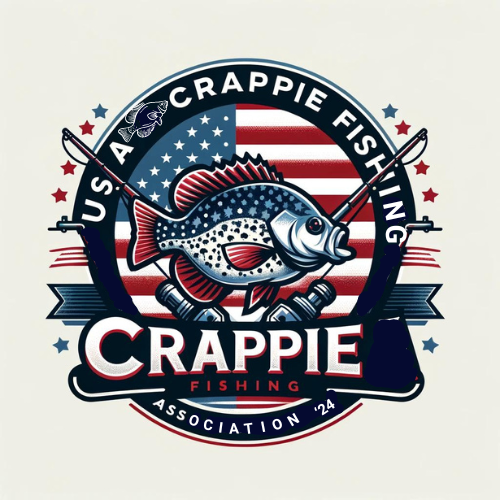“Fishing is much more than fish. It is the great occasion when we may return to the fine simplicity of our forefathers.” – Herbert Hoover
When it comes to fishing, there is something magical about being able to connect with nature and tap into the wisdom of our ancestors. One such endeavor that has captured the imagination of anglers is crappie fishing. Known for their delicious taste and challenging nature, crappie offer an exhilarating experience for fishing enthusiasts.
But catching enough crappie for a fish fry can be quite a task. It requires knowledge of the best fishing methods, gear, and fishing hotspots. In this article, I will delve into the secrets of crappie fishing hotspots and provide you with valuable insights to help you reel in a bountiful catch.
Key Takeaways:
- Understanding the simplicity and joy of fishing can enhance the fishing experience.
- Catching enough crappie requires knowledge of the best fishing methods, gear, and fishing hotspots.
- This article will provide valuable insights to help you reel in a bountiful catch.
Choosing the Right Gear
When it comes to crappie fishing, having the right gear can make all the difference. Different fishing methods require specific tools and equipment to maximize your chances of success. Let’s take a look at the gear you’ll need for various techniques:
1. Bobber and Minnow Rig
The bobber and minnow rig is a classic and effective method for catching crappie. To set up this rig, you’ll need:
- A bobber
- A small hook
- A split-shot sinker
- Live minnows
- A fishing rod and reel combo
2. Spider Rigging
Spider rigging involves trolling with multiple rods, allowing you to cover a larger area and increase your chances of finding crappie. To set up a spider rig, you’ll need:
- Multiple fishing rods and reels
- Rod holders
- Crappie rigs or spider rig setup
- Baits such as live minnows or jigs
3. Jig Fishing
Jig fishing offers versatility and can be done through casting or vertical presentation. To jig fish for crappie, you’ll need:
- Jigs in various colors and sizes
- A jigging rod and reel combo
- Line or leader material
- Bait scent or attractant
4. Shooting Jigs
Shooting jigs is a technique used to reach hard-to-reach places where crappie tend to hide. To shoot jigs, you’ll need:
- Jigs with a long, slim design
- A sensitive spinning rod and reel combo
- Line with low memory
- Weights
- Baits such as soft plastics or marabou jigs
5. Fishing with Crankbaits
If you’re targeting big crappie in open water, fishing with crankbaits can be highly effective. To fish with crankbaits, you’ll need:
- A selection of crankbaits in different colors and sizes
- A casting or spinning rod and reel combo
- Line or leader material
- Bait scent or attractant
Remember to choose the gear that best suits your fishing style and the specific conditions you’ll be facing. Having the right fishing tackle, boat accessories, and fishing gear can significantly improve your chances of landing more crappie.
| Fishing Method | Required Gear |
|---|---|
| Bobber and Minnow Rig | Bobber, small hook, split-shot sinker, live minnows, fishing rod and reel combo |
| Spider Rigging | Multiple fishing rods and reels, rod holders, crappie rigs or spider rig setup, baits |
| Jig Fishing | Jigs in various colors and sizes, jigging rod and reel combo, line or leader material, bait scent or attractant |
| Shooting Jigs | Long, slim jigs, sensitive spinning rod and reel combo, line with low memory, weights, baits |
| Fishing with Crankbaits | Crankbaits in different colors and sizes, casting or spinning rod and reel combo, line or leader material, bait scent or attractant |
Knowing the Best Baits
When it comes to crappie fishing, choosing the right baits can make all the difference. While live minnows are the tried and true bait for crappie, there are also various artificial lures that can be highly effective. Anglers have had great success using crankbaits and plastic jigs to entice these tasty fish.
Spider rigging, a popular crappie fishing technique, often involves using live minnows as bait. The movement and scent of these live baits can attract crappie and entice them to strike. Live minnows can be hooked through the lips or behind the dorsal fin to keep them lively and swimming naturally.
But live minnows aren’t the only option. Artificial lures like crankbaits and plastic jigs are also productive choices. Crankbaits mimic the movement of injured baitfish, which can trigger a feeding response from hungry crappie. Plastic jigs, on the other hand, come in a variety of colors and sizes, allowing anglers to match the hatch and experiment with different presentations.
When the conditions get tough, it’s important to have a selection of baits and be prepared to switch it up. Crappie can be finicky at times, so having a variety of options will increase your chances of success. Additionally, anglers can also try chumming the water to attract crappie, creating a feeding frenzy that can lead to more bites.
A successful day on the water often involves some trial and error. Don’t be afraid to experiment with different baits and techniques until you find what works best for you. Remember, crappie are opportunistic feeders, and they can be caught with various baits and lures. Keep an open mind and be willing to adapt to the conditions to increase your chances of landing a trophy crappie.
| Crappie Baits | Pros | Cons |
|---|---|---|
| Live Minnows | Realistic movement and scent | May require additional equipment for keeping minnows alive |
| Crankbaits | Mimic injured baitfish, trigger feeding response | Requires practice to effectively use crankbaits |
| Plastic Jigs | Wide variety of colors and sizes available | May not have the same realistic movement as live bait |
Expert Tip:
When using plastic jigs, try different colors and sizes until you find what works best. It’s also important to experiment with different retrieval speeds and techniques, such as jigging or slow dragging, to trigger strikes from crappie.
Finding the Right Fishing Spots
When it comes to crappie fishing, finding the right fishing spots is key to a successful angling experience. Crappie can be found in various habitats, and understanding their preferences can greatly improve your chances of catching them. In this section, I will discuss some of the best fishing spots and crappie habitats where you can reel in a trophy-worthy catch.
1. Deep Structures and Timber
One of the prime fishing spots for crappie is near deep structures and standing timber. Crappie tend to seek shelter and food around submerged trees, stumps, and other submerged structures. These areas provide ample hiding spots for crappie and attract baitfish, making them ideal feeding grounds. By targeting these fishing spots, you increase your chances of hooking a large crappie.
2. Weed Beds and Brush Piles
Weed beds and brush piles also serve as excellent crappie habitats. These areas provide cover and serve as nurseries for baitfish. Crappie take advantage of the abundant food supply and can often be found lurking around these spots. By casting your line near weed beds and brush piles, you heighten your chances of landing a trophy crappie.
3. Shoreline Cypress Trees and Stickups
Shoreline cypress trees and stickups are another favorite haunt of crappie. These submerged structures offer shade, cover, and a prime feeding zone for crappie. They are particularly productive fishing spots during the spawning period when crappie seek sheltered areas to lay their eggs.
4. Shallow Water near Channel Edges and Main Lake Humps
For those looking to catch larger crappie, targeting shallow water near channel edges and main lake humps can yield fruitful results. These areas act as ambush points for crappie, providing them with access to deep water while allowing easy access to prey in shallower areas.
5. Productive Fishing Spots from the Shore
Not everyone has access to a boat, but that doesn’t mean you can’t find productive fishing spots for crappie. Many crappie hotspots are accessible from the shore. By identifying areas with the right habitat features, such as submerged structures, weed beds, and shoreline cover, you can find a wealth of fishing opportunities close to home.
Remember, when looking for crappie fishing spots, it’s essential to consider their habitats and feeding preferences. By targeting the areas mentioned above, you will increase your chances of landing the coveted crappie. Whether you choose to fish near deep structures, weed beds, or shoreline cover, always keep in mind the specific needs and behaviors of crappie.
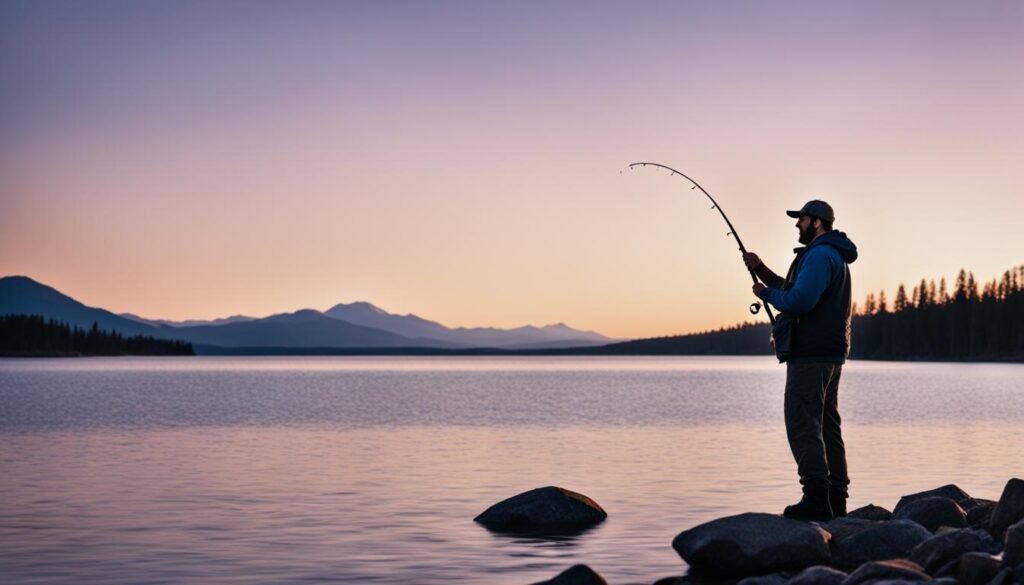
| Fishing Spot | Description |
|---|---|
| Deep Structures and Timber | Areas with submerged trees and structures that provide shelter and food sources for crappie. |
| Weed Beds and Brush Piles | Locations with dense weed beds and brush piles that attract baitfish and serve as feeding grounds for crappie. |
| Shoreline Cypress Trees and Stickups | Submerged cypress trees and stickups along the shoreline that offer shade, cover, and a prime feeding zone for crappie. |
| Shallow Water near Channel Edges and Main Lake Humps | Shallow areas near channel edges and underwater humps that act as ambush points for crappie. |
| Productive Fishing Spots from the Shore | Areas accessible from the shore that feature the right habitat elements, such as submerged structures and shoreline cover. |
Understanding Seasonal Habits
Crappie fishing is a year-round activity, but knowing the seasonal habits of these elusive fish can greatly enhance your success on the water. Let’s explore the different behaviors and patterns of crappie during winter, fall, and post-spawn periods.
Winter Crappie Fishing
During the winter months, crappie tend to gather in large schools near underwater structures. These structures provide shelter and attract baitfish, making them ideal feeding grounds for crappie. To locate winter crappie, focus your efforts around submerged trees, brush piles, and drop-offs.
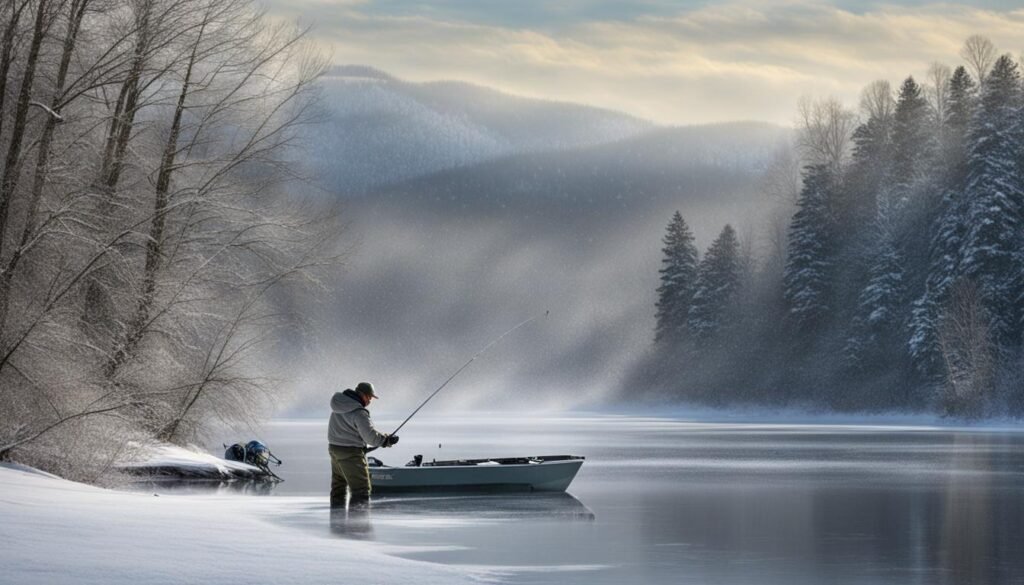
Heavy jigs or live minnows are effective bait choices for winter crappie. Slow presentations and subtle movements are more appealing to lethargic crappie in colder water temperatures.
Fall Crappie Fishing
In the fall, crappie can often be found near docks and structures. These areas provide cover and make excellent ambush spots for feeding crappie. Successful fall crappie fishing often involves targeting docks, piers, and other man-made structures.
Night fishing can also be productive during the fall season. Crappie become more active under the cover of darkness, venturing out to feed. Utilize fishing lights to attract crappie and increase your chances of success.
Post-Spawn Crappie
After the spring spawn, crappie move to deeper water and disperse throughout their habitat. During this period, they are in search of food to replenish their energy reserves. Look for crappie near submerged vegetation, drop-offs, and underwater humps.
Plastic jigs, minnow imitations, and small crankbaits are popular choices for post-spawn crappie. Experiment with different colors and retrieve speeds to entice feeding crappie.
Understanding the seasonal habits of crappie allows anglers to target specific locations and use the most effective techniques for each time of year. By adapting to the changing seasons, you can maximize your catch rates and make the most of your time on the water.
Crappie Fishing in Florida
Florida offers excellent crappie fishing opportunities year-round, with the peak season being from late fall to early spring. The state boasts numerous water systems and lakes that are home to a large population of crappie. Considered both a sportfish and a panfish, crappie fishing in Florida is a popular activity for anglers of all skill levels.
When it comes to winter crappie fishing, Florida is a top destination due to its mild climate and abundant freshwater resources. Anglers can enjoy the thrill of catching crappie in picturesque settings while avoiding the harsh winter conditions found in other parts of the country. Whether you prefer fishing from a boat or casting from the shore, Florida’s diverse fishing opportunities cater to everyone’s preferences.
One of the key advantages of crappie fishing in Florida is the availability of local experts who possess in-depth knowledge of the species and their behaviors. These knowledgeable individuals can provide valuable insights and tips to enhance your fishing experience. They are also well-versed in the best techniques and strategies to increase your chances of landing a bountiful catch in the Sunshine State.
In summary, if you’re looking for an unforgettable freshwater fishing adventure, consider heading to Florida for an exceptional crappie fishing experience. With its year-round fishing opportunities, diverse water systems, and expert advice available, Florida is a dream destination for any angler seeking to reel in trophy-worthy crappie.
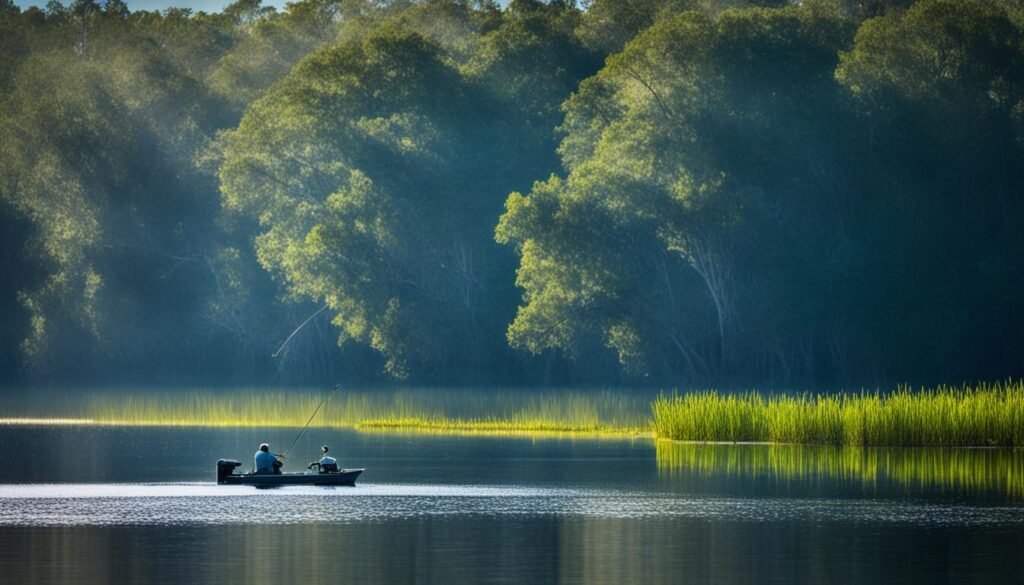
| Benefits of Crappie Fishing in Florida |
|---|
| Year-round fishing opportunities |
| Abundance of freshwater resources |
| Mild winter climate |
| Diverse fishing locations |
| Access to local fishing experts |
Summer Crappie Fishing at Night
During the summer, crappie often feed more actively at night. Fishing for crappie at night can be very productive if planned properly. Choosing the right fishing spot, using the right fishing lights, and setting up multiple fishing rigs are important for success. Understanding the movements of crappie during the summer and using the right fishing baits and hooks can improve catch rates.
Choosing the Right Fishing Spot
When fishing for crappie at night, it’s essential to select the right fishing spot. Look for areas that provide cover and are known as feeding grounds for crappie. These include submerged structures, weed beds, brush piles, and artificial reefs. Pay attention to the water temperature and depth, as crappie tend to seek cooler and deeper areas during the summer months.
Using the Right Fishing Lights
Fishing lights are crucial for attracting crappie at night. Choose high-quality and waterproof fishing lights that emit a bright and steady glow. These lights will attract zooplankton, which in turn attract baitfish, and eventually, the crappie. It’s recommended to use submersible fishing lights that can be easily attached to boats or fishing rigs.
Setting up Multiple Fishing Rigs
Setting up multiple fishing rigs can maximize your chances of catching crappie at night. Use a combination of bobbers, weighted jigs, and live bait rigs to target different depths. Crappie may be located at varying depths depending on their feeding patterns and the water conditions. By setting up rigs at different depths, you increase your chances of intercepting crappie in their preferred hunting zones.
Understanding the Movements of Crappie during the Summer
As the temperature rises during the summer, crappie tend to move to deeper waters during the day and become more active at night. They may also concentrate near underwater structures or in the vicinity of submerged vegetation. Understanding the movements and behavior of crappie during the summer can help you determine the best time and location to target them at night.
Using the Right Fishing Baits and Hooks
Choosing the right fishing baits and hooks is crucial for enticing crappie to bite at night. Popular bait options for crappie include minnows, nightcrawlers, and artificial lures such as soft plastic jigs. Experimenting with different colors and sizes can help you identify the most effective baits for the specific crappie population you are targeting. Pair your baits with the appropriate hooks, such as size 2 or 4 Aberdeen hooks, for improved hooksets.
| Bait | Description |
|---|---|
| Minnows | Live minnows are a popular and effective bait choice for crappie. They can be fished on a simple hook and bobber rig or used as part of a larger setup like a Carolina rig. |
| Nightcrawlers | Nightcrawlers are another natural bait option that can entice crappie to bite. They can be fished on a small hook with a split-shot weight to ensure proper presentation. |
| Soft Plastic Jigs | Soft plastic jigs mimic the appearance and movement of small baitfish and can be an effective lure for crappie. They can be rigged on a jig head and retrieved with a slow and steady retrieve. |
By following these tips and techniques, you can increase your chances of a successful summer crappie fishing trip at night. Remember to check local fishing regulations, have the necessary fishing licenses, and prioritize safety while enjoying your angling adventures.
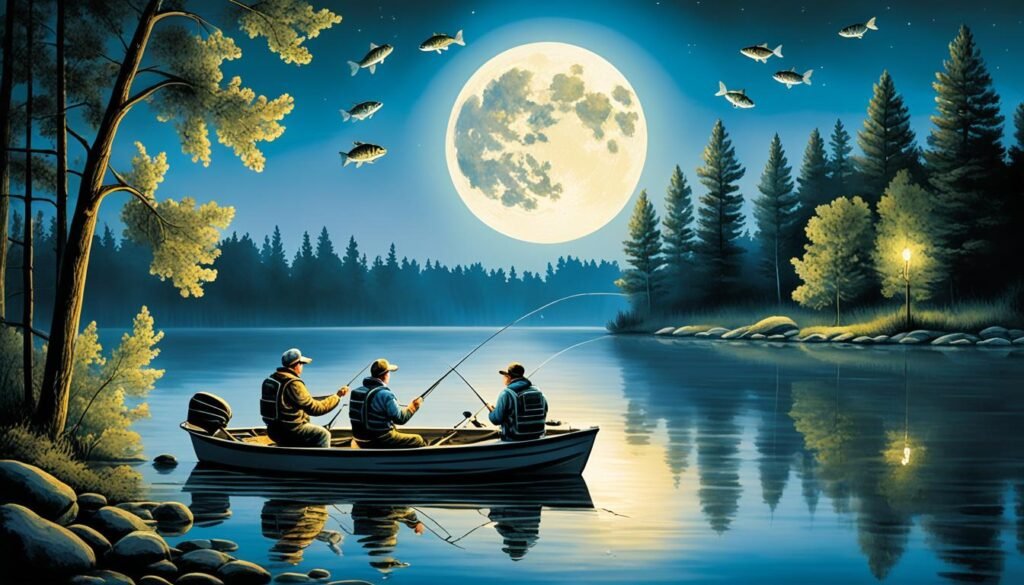
Fishing Rigs and Techniques for Night Fishing
When it comes to night fishing for crappie, using the right fishing rigs and techniques can make all the difference. By employing strategic methods and optimizing your gear, you can increase your chances of a successful catch. Here are some tips to help you make the most out of your nighttime fishing adventures:
1. Multiple Fishing Rigs and Depth Setting
Setting up multiple fishing rigs at different depths is a proven tactic for zeroing in on crappie. This allows you to cover more water and increases your chances of enticing a bite. Experiment with various rig setups, such as slip bobbers, Carolina rigs, or dropper loops, to find the most effective combination for your fishing environment.
2. Choosing the Right Hook and Marking Equipment
Visibility is crucial when fishing in the dark. Opt for hooks with fluorescent or glow-in-the-dark finishes to enhance their visibility underwater. Additionally, marking your fishing equipment with glow sticks or light-reflective tape will help you keep track of your gear and prevent tangles in the dark.
3. Attracting Crappie with Lights
Using lanterns, submersible fishing lights, or black lights can attract crappie to your fishing spot. These light sources create an underwater glow that draws in curious crappie and increases your chances of bites. Strategically position your lights to illuminate the water around your fishing rigs and maximize their effectiveness.
4. Adapting Fishing Techniques to Crappie Movements
Crappie exhibit certain behaviors and movements at night, and understanding these patterns will give you an edge. Pay attention to the depth at which crappie are biting and adjust your fishing technique accordingly. If they are found closer to the surface, consider using float fishing or retrieve techniques. If they are deeper, try vertical jigging or slow trolling to target them effectively.
By utilizing these fishing rigs and techniques for night fishing, you can improve your chances of landing crappie even in the darkest hours. Remember to always prioritize safety when fishing at night and be equipped with proper lighting, navigation tools, and personal flotation devices. With the right approach, nighttime can be the perfect time for successful crappie fishing adventures.
Conclusion
Crappie fishing is an exhilarating and fulfilling pursuit that offers anglers the opportunity to reel in a prized catch. To maximize your crappie fishing success, it is essential to employ effective fishing tips and techniques. By carefully selecting the right gear, understanding the best baits to use, identifying the ideal fishing spots, and recognizing seasonal habits, you can significantly enhance your chances of landing a prized crappie.
When it comes to gear, choosing the appropriate fishing tackle and boat accessories is crucial. Different fishing methods require specific equipment, so it is important to be well-prepared and equipped with the necessary tools for your preferred technique. Additionally, knowing the right baits to use, such as live minnows, crankbaits, and plastic jigs, can greatly increase your chances of attracting crappie and enticing them to bite.
Understanding where to find crappie is also key to a successful fishing trip. Crappie tend to inhabit areas with deep structures, standing timber, weed beds, and brush piles. By familiarizing yourself with their preferred habitats, such as shoreline cypress trees, stickups, and cover-button willows, you can increase your chances of locating concentrations of crappie.
Lastly, being aware of seasonal habits and adjusting your fishing techniques accordingly can make a significant difference in your success rate. Different seasons present different challenges and opportunities. Whether it’s winter crappie fishing near structures, fall crappie fishing near docks, or summer night fishing when crappie are more active, adaptability and knowledge are paramount to achieving favorable results.
